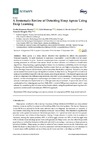Identificador persistente para citar o vincular este elemento:
https://accedacris.ulpgc.es/jspui/handle/10553/64233
| Campo DC | Valor | idioma |
|---|---|---|
| dc.contributor.author | Shanawaz Mostafa, Sheikh | - |
| dc.contributor.author | Mendonça, Fábio | - |
| dc.contributor.author | Ravelo-García, Antonio G. | - |
| dc.contributor.author | Morgado-Dias, Fernando | - |
| dc.date.accessioned | 2020-01-22T14:41:42Z | - |
| dc.date.available | 2020-01-22T14:41:42Z | - |
| dc.date.issued | 2019 | - |
| dc.identifier.issn | 1424-8220 | - |
| dc.identifier.other | Scopus | - |
| dc.identifier.uri | https://accedacris.ulpgc.es/handle/10553/64233 | - |
| dc.description.abstract | Sleep apnea is a sleep related disorder that significantly affects the population. Polysomnography, the gold standard, is expensive, inaccessible, uncomfortable and an expert technician is needed to score. Numerous researchers have proposed and implemented automatic scoring processes to address these issues, based on fewer sensors and automatic classification algorithms. Deep learning is gaining higher interest due to database availability, newly developed techniques, the possibility of producing machine created features and higher computing power that allows the algorithms to achieve better performance than the shallow classifiers. Therefore, the sleep apnea research has currently gained significant interest in deep learning. The goal of this work is to analyze the published research in the last decade, providing an answer to the research questions such as how to implement the different deep networks, what kind of pre-processing or feature extraction is needed, and the advantages and disadvantages of different kinds of networks. The employed signals, sensors, databases and implementation challenges were also considered. A systematic search was conducted on five indexing services from 2008–2018. A total of 255 papers were found and 21 were selected by considering the inclusion and exclusion criteria, using the preferred reporting items for systematic reviews and meta-analyses (PRISMA) approach. | - |
| dc.language | eng | - |
| dc.relation.ispartof | Sensors | - |
| dc.source | Sensors (Switzerland) [ISSN 1424-8220], v. 19 (22), 4934 | - |
| dc.subject | 6105 Evaluación y diagnóstico en psicología | - |
| dc.subject.other | CNN | - |
| dc.subject.other | Deep learning | - |
| dc.subject.other | Sleep apnea | - |
| dc.subject.other | Sensors for sleep apnea | - |
| dc.subject.other | RNN | - |
| dc.subject.other | Deep neural network | - |
| dc.title | A systematic review of detecting sleep apnea using deep learning | - |
| dc.type | info:eu-repo/semantics/article | - |
| dc.type | Article | - |
| dc.identifier.doi | 10.3390/s19224934 | - |
| dc.identifier.scopus | 85074857183 | - |
| dc.identifier.isi | 000503381500113 | - |
| dc.contributor.authorscopusid | 55489640900 | - |
| dc.contributor.authorscopusid | 57195946416 | - |
| dc.contributor.authorscopusid | 9634135600 | - |
| dc.contributor.authorscopusid | 57200602527 | - |
| dc.identifier.eissn | 1424-8220 | - |
| dc.identifier.issue | 4934 | - |
| dc.relation.volume | 19 | - |
| dc.investigacion | Ingeniería y Arquitectura | - |
| dc.type2 | Artículo | - |
| dc.contributor.daisngid | 4069296 | - |
| dc.contributor.daisngid | 6442981 | - |
| dc.contributor.daisngid | 1986395 | - |
| dc.contributor.daisngid | 1189663 | - |
| dc.description.numberofpages | 26 | - |
| dc.utils.revision | Sí | - |
| dc.contributor.wosstandard | WOS:Mostafa, SS | - |
| dc.contributor.wosstandard | WOS:Mendonca, F | - |
| dc.contributor.wosstandard | WOS:Ravelo-Garcia, AG | - |
| dc.contributor.wosstandard | WOS:Morgado-Dias, F | - |
| dc.date.coverdate | Noviembre 2019 | - |
| dc.identifier.ulpgc | Sí | es |
| dc.description.sjr | 0,653 | |
| dc.description.jcr | 3,275 | |
| dc.description.sjrq | Q1 | |
| dc.description.jcrq | Q1 | |
| dc.description.scie | SCIE | |
| item.fulltext | Con texto completo | - |
| item.grantfulltext | open | - |
| crisitem.author.dept | GIR IDeTIC: División de Procesado Digital de Señales | - |
| crisitem.author.dept | IU para el Desarrollo Tecnológico y la Innovación | - |
| crisitem.author.dept | Departamento de Señales y Comunicaciones | - |
| crisitem.author.orcid | 0000-0002-8512-965X | - |
| crisitem.author.parentorg | IU para el Desarrollo Tecnológico y la Innovación | - |
| crisitem.author.fullName | Ravelo García, Antonio Gabriel | - |
| Colección: | Artículos | |
Citas SCOPUSTM
135
actualizado el 08-jun-2025
Citas de WEB OF SCIENCETM
Citations
101
actualizado el 08-jun-2025
Visitas
117
actualizado el 01-feb-2025
Descargas
139
actualizado el 01-feb-2025
Google ScholarTM
Verifica
Altmetric
Comparte
Exporta metadatos
Los elementos en ULPGC accedaCRIS están protegidos por derechos de autor con todos los derechos reservados, a menos que se indique lo contrario.
